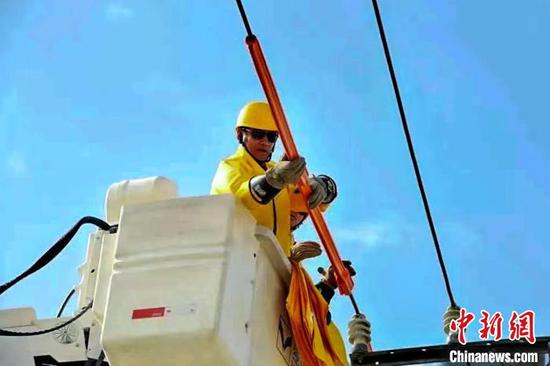I have witnessed rapid development of Tibet power industry: NPC deputy
(ECNS) -- "My hometown is Riwoqe County in Qamdo Prefecture, Tibet Autonomous Region. I used oil lamps when I was a child and had electric lights during elementary and middle school, but at that time, power outages were frequent. Nowadays, Tibet definitely does not lack electricity, " said Zhaxi Nyima, who is a deputy team leader at the urban power supply service center of State Grid Lhasa Power Supply Company as well as a deputy to the 14th National People's Congress.

Zhaxi Nyima is repairing electricity failure. (Photo provided from Zhaxi Nyima)
During an interview with China News Network, Zhaxi Nyima told the story of how the residents in his hometown had access to electricity at first and then, an upgraded power supply service.
He recalled that in 1990, he left home for the first time to attend a hydroelectric technical school in Lhasa.
"At that time, the Lhasa urban area mainly relied on the Najin hydroelectric power station for electricity. During the peak season in winter, each area took turns to get power supply, including schools," he said.
After graduating in 1993, Zhaxi Nyima was assigned to work at the Najin Hydropower Station, where he was responsible for the operation and maintenance of the generator units.
"My job was to monitor the four hydroelectric turbine units. During the summer when the water flow in the Lhasa River was high, all four units would operate. But when the water flow reduced in winter, only two units could operate," Zhaxi Nyima said. adding that not until the end of the 1990s did Lhasa city solved power shortages.
In 2005, he joined the urban distribution repair team to repair power failures in residential areas.
Afterward, the development of Tibet's electric power industry entered the "fast lane."
At the end of 2011, the Qinghai-Tibet Grid Interconnection Project with a total investment of 16.286 billion yuan ($2.34 billion ) was put into operation; On November 20, 2014, the Sichuan-Tibet Power Grid Interconnection Project, which connected the Qamdo power grid in Tibet and the power grid in Sichuan, was put into operation.
On November 23, 2018, the Central Tibet Power Grid Interconnection Project, which broke multiple records in the construction and operation of power grid projects, was completed and put into operation.
In December 2020, the Ali-Tibet Central Power Grid Interconnection Project was officially put into operation, marking Tibet's entry into the era of a unified power grid covering all 7 cities and 74 counties (districts) in the region.
"Now that people have sufficient electricity, we are thinking about how to upgrade power supply services," he said.
In the past, the electric wires in the old area of Lhasa were like spider webs, intertwined with various pipelines, resulting in high failure rates and difficulty in repairing.
"For example, if a large courtyard in a street reported a power outage, we had to climb up the electric pole while another colleague would search for the corresponding faulty line nearby and pull it so that we could find the specific failured line, reconnect it, and restore power," he said.
"Later, the old city area was renovated, and all pipelines were placed underground, and the spider web-like electric wires became a thing of the past," he added.
In order to further improve the experience of residents using electricity, Zhaxi Nyima and three others were sent to other provinces by their company in 2016 to learn about live-line work and emergency repairs. In 2017, the Live-Line Operation and Maintenance Team was officially established in Lhasa City Power Supply Service Center.
"Now, for some faults, we can quietly fix them during live-line work, without power outages, and the people are actually unaware of the process," said Zhaxi Nyima. He added that this is a kind of progress, indicating that the electricity-using experience of the Tibetan people is improving.
According to official information released by the Tibet Autonomous Region in October 2022, the cumulative investment in the construction of the Tibet power grid reached nearly 70 billion yuan in the past decade, exceeding the total investment in power grid construction over the past 60 years.
The State Grid Tibet Electric Power Co., Ltd. has reported that the electricity consumption in Tibet has maintained a double-digit growth rate for several years, increasing from 2.77 billion kilowatt-hours in 2012 to 11.86 billion kilowatt-hours in 2022.
"I have witnessed the rapid development of the Tibet power industry," Zhaxi Nyima said.
Photos
Related Stories
- Feature: A Tibetan woman's quest to predict quakes
- Population of black-necked cranes surpasses 10,000 in Tibet, China
- Tibetan carpet industry thawing through innovation
- Tibet's Burang port resumes two-way cargo passing
- Tibet announces regulations to support small enterprises
- Courier service delivers better life to Tibetan border counties
Copyright © 2023 People's Daily Online. All Rights Reserved.









